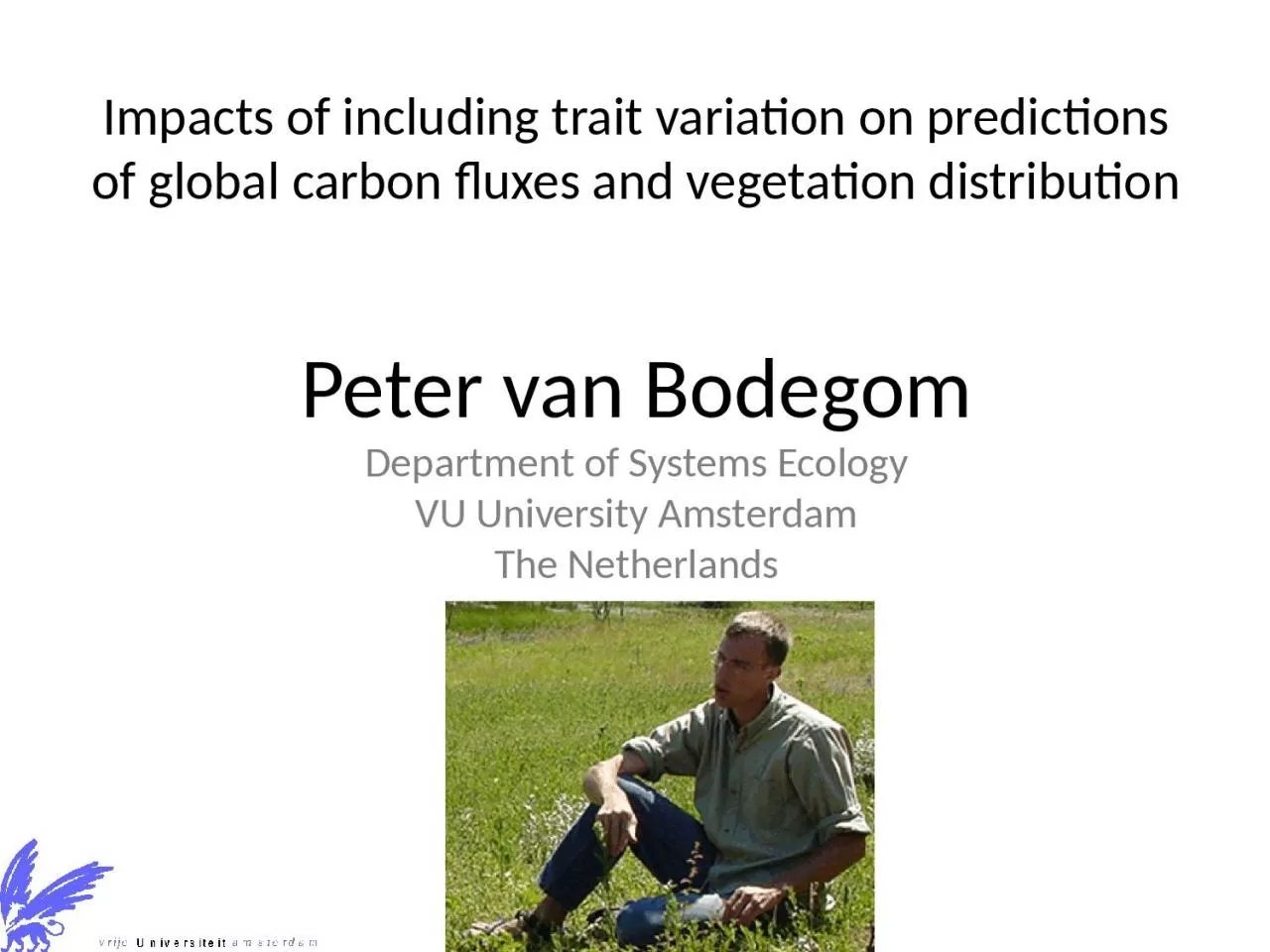

Peter van Bodegom Department of Systems Ecology VU University Amsterdam The Netherlands Traits vary considerably within and between communities Kattge et al 2011 GCB Traits also tend to respond to climate manipulations ID: 1032474
Download Presentation The PPT/PDF document "Impacts of including trait variation on ..." is the property of its rightful owner. Permission is granted to download and print the materials on this web site for personal, non-commercial use only, and to display it on your personal computer provided you do not modify the materials and that you retain all copyright notices contained in the materials. By downloading content from our website, you accept the terms of this agreement.
1. Impacts of including trait variation on predictions of global carbon fluxes and vegetation distributionPeter van BodegomDepartment of Systems EcologyVU University AmsterdamThe Netherlands
2. Traits vary considerably within and between communitiesKattge et al. 2011 GCB
3. Traits also tend to respond to climate manipulationsCornelissen et al. 2007 EcolLett; Aerts, van Bodegom and Cornelissen 2012 New Phytol
4. This trait variation is not well-captured by classification in biomes/PFTs Van Bodegom et al. 2012 GEB
5. Keeping trait values PFT-constant within DGVMs has various disadvantagesVan Bodegom et al. 2012 GEBConstant trait values in modelling hampers:including acclimation and adaptation processesAccounting for non-random species turnoverQuantifying vegetation-environment feedbacksFor these reasons, trait variation/responses are increasingly incorporated into the DGVMs
6. A partial solution: incorporation of observation-driven trait/process estimatesBrovkin et al. 2012 BiogeosciencesGlobal litter stocksCornwell et al. 2008 EcolLett
7. Potential solutions for further incorporating trait responses/ranges into DGVMs more PFTSIncorporating variation within PFTs:Based on habitat filtering principlesBased on evolutionary principles3. Fully traits-based approach
8. 1. More PFTs may not be a fruitful approach given functional redundancyobservedpredicted
9. 2a. Incorporation of trait variation within PFTs: habitat filtering principlesBased on assembly theory: environment acts a ‘filter’Filtering by environmentPotential range of trait valuesTrait range in habitat 1Trait range in habitat 2Ordonez et al. 2009 GEB
10. 2a. Incorporation of habitat filtering principles into JSBACHFor PFT 1: trait X = a * temperature + b * radiation + CO2-acclimationC3-grassesDefault: fixed traits variable traits responsesC3-grassesVerheijen et al. 2012 Biogeosci.Disc.
11. 2a. JSBACH-simulated trait variation based on habitat filteringRed dots: fixed values from default settingVerheijen et al. 2012 Biogeosci.Disc.
12. 2a. Impacts of JSBACH-simulated trait variation on productivityVerheijen et al. 2012 Biogeosci.Disc.
13. 2a. Impacts of JSBACH-simulated trait variation on vegetation distributiondefaultvariable traits
14. 2a. Impacts of JSBACH-simulated trait variation on future carbon sinkVerheijen et al. 2012 in prep.
15. 2b. Incorporation of trait variation based on evolutionary principlesVan Bodegom & Franklin in prep.- Forest stand model- No water limitation- Maximizing net growth & reproduction
16. 2b. Incorporation of trait variation based on evolutionary principles: on-site evaluation of variable allocationVan Bodegom & Franklin in prep.Fixed allocationOptimal allocation
17. 3. A fully traits-based approach: separating trait predictions from vegetation distribution predictionsDouma et al 2012 EcographyVan Bodegom et al. in revision
18. 3. Trait predictions based on trait-environment relationshipsVan Bodegom et al. in revision
19. 3. Predicting vegetation probabilities from traits: kernel density fittingDouma et al 2012 Ecography Van Bodegom et al. in revisionSSDLMASeed massBiome ABiome BBiome CSeed massLMASSDFor each position in trait space, multiple plant functional types may in principle be possible. The probability of each is described by Gaussian kernels
20. 3. Predicting vegetation probabilities from traits: global vegetation distributionVan Bodegom et al. in revision
21. ConclusionsTrait responses to climate (manipulations) are important and strong impact (predictions of ) vegetation distribution and functioning.There are multiple ways to continue refining DGVMs.Exchange of ideas between modellers and experimentalists will remain essential for more reliable predictions of our future climate.
22. Douma et al 2012b Ecography
23.
24.
25.
26.